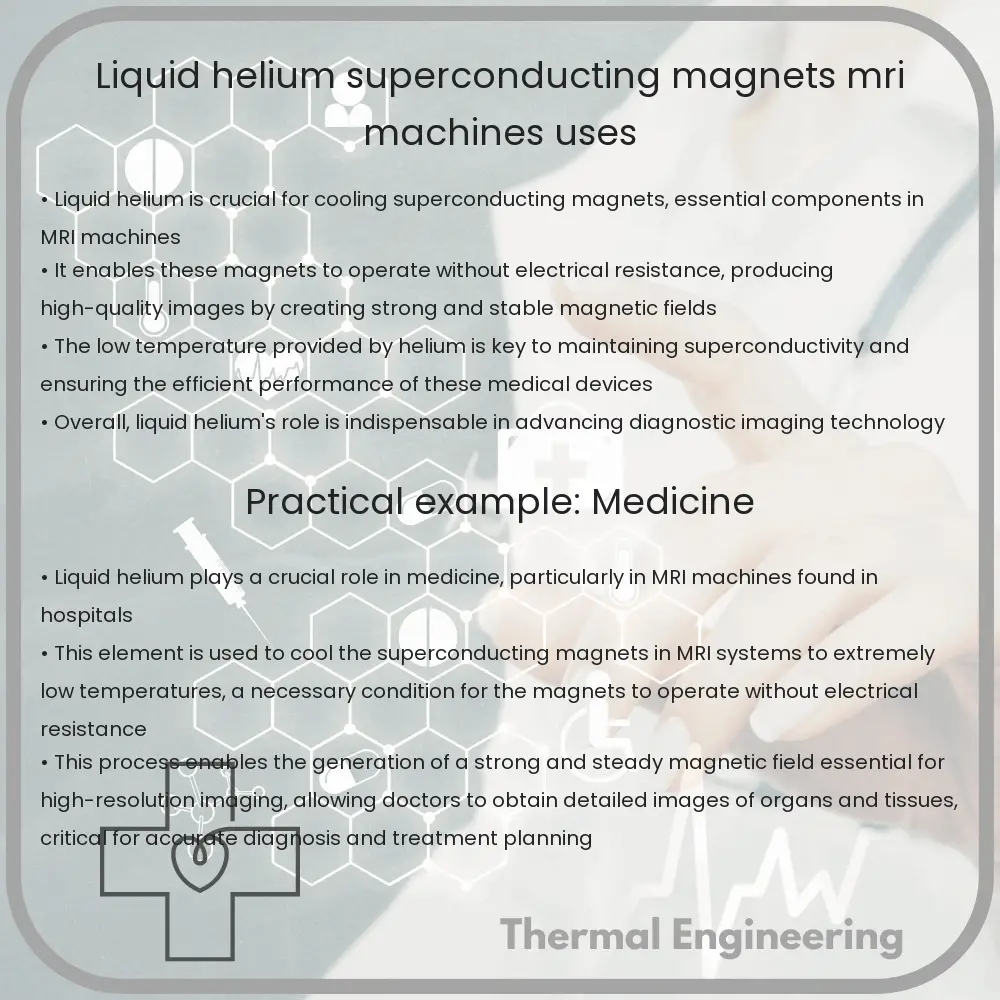Liquid helium – a crucial coolant in superconducting magnets key for MRI machines and scientific apparatus, detailed in effects and application challenges.

Liquid Helium and Its Crucial Role in Superconducting Magnets and MRI Machines
Liquid helium is an essential component in the operation of superconducting magnets, which form the core of modern magnetic resonance imaging (MRI) machines, as well as other critical scientific instruments. This article explores the properties of liquid helium, how it enables superconductivity in magnets, and its specific use in MRI technology.
What is Liquid Helium?
Helium becomes a liquid at extremely low temperatures, below -269 degrees Celsius (-452.2 degrees Fahrenheit). At this temperature, referred to as the boiling point, liquid helium has unique properties such as superfluidity (the ability to flow without friction) and extremely low density. Most importantly for engineering applications, liquid helium is an excellent coolant, capable of reaching temperatures close enough to absolute zero needed for superconductivity.
Superconductivity and Superconducting Magnets
Superconductivity is a phenomenon of exactly zero electrical resistance occurring in certain materials when cooled below a characteristic critical temperature. Superconducting magnets, which are electromagnets made typically from coils of superconducting wire, are able to carry a much larger amount of electric current without resistance. The absence of electrical resistance means these magnets can create large and sustained magnetic fields.
- Superconducting magnets are crucial in a range of applications, from the Large Hadron Collider, which uses them to steer particles at high speeds, to Magnetic Levitation (Maglev) trains, which use them to lift and propel the train forwards.
Role of Liquid Helium in MRI Machines
Magnetic Resonance Imaging (MRI) machines use superconducting magnets to generate a powerful and stable magnetic field necessary for high-resolution imaging without ionizing radiation. The magnets used in MRI machines are composed of coils of superconducting wire that are cooled to superconductive temperatures by liquid helium.
- The MRI scanner’s superconducting magnet is cooled to approximately 4.2 Kelvin (-269°C; -452°F) using liquid helium.
- This extreme cooling is essential to reduce the resistance in the coil to virtually zero, allowing a high current to flow through the magnet and create a strong magnetic field.
- The intense magnetic field is uniform and stable, enabling the MRI machine to capture detailed images of organs and structures within the body.
Challenges and Innovations
Despite its critical role, the use of liquid helium poses several challenges. It is relatively scarce and requires complex infrastructure for storage and handling due to its extremely low temperature requirements. Additionally, helium is expensive, and the cost can impact the overall expense of operating MRI machines and other devices relying on superconducting magnets.
- Technological advances aim to reduce helium usage, either by recycling it within the system or developing MRI machines that can operate at higher temperatures using high-temperature superconductors.
In summary, liquid helium plays an indispensable role in the operation of superconducting magnets, paramount to the functionality of MRI machines. Ongoing research and technological developments continue to focus on optimizing helium use and managing its limitations, aiming for more sustainable and efficient applications within these sophisticated engineering systems.